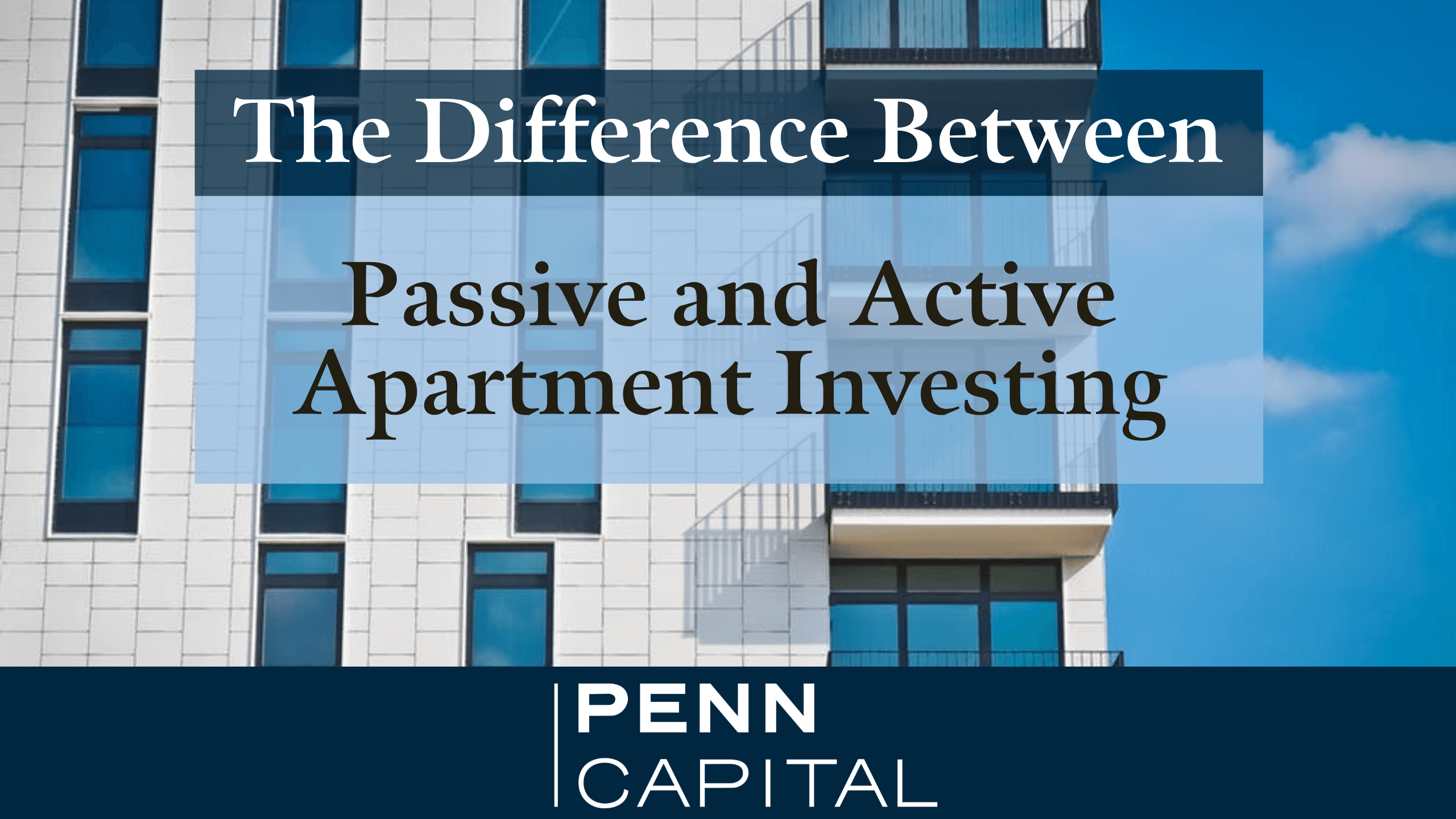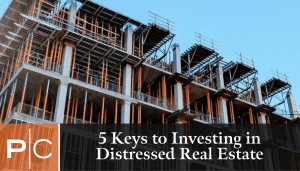Differences Between Passive Vs. Active Investing
By Percy Nikora, Owner/Co-founder

If you’re looking at getting into either passive or active multi-family real estate investing, it’s important to understand the differences between the two. Although in both cases you’re investing in the same asset, an active investor has a vastly different role than a passive investor.
Here are some of the key differences between active and passive investors, as well as lessons I’ve learned throughout my time in real estate investment.
Ahead of the Deal
While a deal is being negotiated and settled, each investor type has their own responsibilities. Let’s start with the active investor, also called the deal sponsor. Active investors are those responsible for due diligence for the deal itself. They are responsible for underwriting the project thoroughly to present it for capital investment.
Beyond due diligence, active investors are also out searching for debt capital. Acquiring debt capital for multi-family is a different process than it would be for single family or other smaller real estate projects.
Lenders provide anywhere from 70-80% of necessary capital for multi-family and always perform their own due diligence on the sponsor as well as on the project. They will look to the sponsor’s track record and want to see that they have done similar projects in the past, have the expertise to succeed, and meet their liquidity and net worth requirements.
The nature of the debt and the deal determines which type of lender you need to approach. Different lenders should be approached for heavy value add properties versus stabilized assets. Experienced sponsors are able to negotiate loan terms with lenders to ensure they’re getting what they need without having to jump through too many hoops.
It’s not only the sponsor who will be involved in the lending process. Many attorneys and supporting staff are also involved in securing lending. It’s a complex process, usually taking up to 90 days to get everything done, though in some circumstances it may be as quick as 30-60 days if you plan well enough ahead of time.
Because the team here at Penn Capital have gone through so many deals now, we’ve created a lender package containing information about our schedules of real estate owned, personal financial statements, experience, bios, and other documents. We’ve systemized the process so we can deliver to lenders what they need immediately and this helps in making the process go faster.
Sign up to receive our educational newsletter and to gain exclusive access to our next investment opportunity.
Passive Investor Due Diligence
In contrast to active investors, passive investors perform due diligence on the sponsor in charge of the deal and the deal itself. Understanding and trusting the sponsor is vital, so due diligence here can save a lot of trouble later on. Due diligence seeks to uncover the sponsor’s investing philosophy, plan, experience, and more. The most important task is in ensuring that what the sponsor is offering aligns with what the passive investor is looking to achieve.
Deal information is generally passed to an investor by the sponsor and so it is important that the passive investor carefully looks at the sponsor’s underwriting criteria. Ideally, sponsors should be at least as conservative as the investor when underwriting a deal, using similar assumptions that can be validated.
During the Deal
Active investors have much more responsibility once a deal has begun. They are involved in the day to day decision making and in spending time coordinating the project, keeping up with all parties involved in implementing the business plan and in ensuring returns are delivered to investors.
Active investors are responsible for asset management, which involves observing and monitoring the progress of the real estate assets in the portfolio. This requires regular contact with property managers and others to get updates, sometimes speaking daily with them to keep things going in the right direction, and in making decisions that will affect the future of the asset.
The active investor is especially busy while construction is under way. During this time, they must meet with the architect, construction crews, management, government officials, attorneys, operations crew, lenders, etc. Active investors are like the conductor of an orchestra, making sure every moving piece is working well together towards the right goal.
Passive Investor Duties
Passive investors, in contrast, are not involved in the day to day operations. Managing a real estate portfolio is a fulltime job, so not being involved in daily activities allows passive investors to continue working fulltime jobs or investing in other areas.
That said, being passive does not equate to not taking an interest in progress of a project. Once a deal is ongoing, a passive investor should expect to get regular updates from the sponsor (monthly, quarterly, annually) and be sure to always stay informed and up to date about the investment.
Challenges of Active Investment
If you’re looking for an easy way to cruise through real estate investment, active investing is probably the right option. There are many challenges to investing actively. The biggest one by far is not realizing how much time and effort it takes to manage a successful project.
The second challenge is building the necessary relationships. For example, you need a good relationship with brokers to find the right property, which means proving to those brokers that you can close a deal, especially if you have no track record of having done so before in multi-family in a particular geography.
Once you close on the property, the REAL work begins. At this point, you have to implement your business plan and provide the expected returns to investors and carry out the plans on schedule. Things always come up that you didn’t anticipate. Being able to address that and come up with a good solution on the fly is important. Having a good team of people supporting you is key.
Lessons from Real Estate Investing
In my years doing real estate investment, I’ve had to learn many things the hard way. I started out as a passive investor in multi-family real estate before moving over to active investing. Here’s what I learned along the way.
Hardest Lessons Learned
Even though you may know the sponsor and have history with them, you still have to check the underwriting criteria carefully. People sometimes change the assumptions they use in underwriting. Some sponsors can play with the numbers or relax criteria for underwriting over time. Keep an eye out for this.
Also make sure the exit cap rate is ideally higher than the purchase cap rate. Check to see that the operating assumptions are valid, including that they can actually get the rent they projected in the market and that they can get and maintain the occupancy projected.
Investments must operate like a business. You can’t be partially active and partially passive. You must be fully active or fully passive. There is a lot of time commitment needed to invest actively in larger asset classes and it is important to focus your attention on it with your time and resources – otherwise you shouldn’t be doing it at all.
Another lesson I’ve learned and that is reflected in the way we operate here at Penn Capital is that active investors need to have some skin in the game. This is part of the guiding principles of multi-family investing. It helps demonstrate that you truly believe in the project. It also shows investors that you believe it’s a good deal, because you’re willing to risk your own cash on the same terms. This is a key thing that many passive investors look for in a sponsor.
Hardest Lessons Learned from a Downturn
Projected rents are not always tenable. People get nervous about paying more for rent in a market downturn, and your competitors may reduce rents to compensate for tenant insecurity. You may have to temporarily reduce rents to keep up with the market.
You should also be careful about refinancing during a downturn. It’s better to have built-in extension clauses in your current loan terms rather than refinancing in a tighter loan market.
What Every Investor Should Know
If you’re looking into doing either active or passive investment in multi-family, the key thing you should look for in any deal is a proven ability to move the rents in the market you’re entering. Always make sure underwriting projections are viable. You can do this by looking for successes in the market from other investors taking similar steps.
Just because the sponsor says they can get certain rents doesn’t mean they will be able to with their existing plans. You need to know what needs to be done to drive up rents. Getting the best data helps you plan your budget to know if the deal is still viable or not. Make sure the projections hold true with the real market to get the desired rents. Tweak your assumptions as needed.
Remember that rent growth doesn’t happen instantly. Underwriting should account for the fact that rents increase slowly as new tenants cycle through, construction work is finished, and other factors change. It’s better to be conservative in the assumptions about scaling up, even running the numbers with lower occupancy level assumptions to account for vacancy during construction.
***
Multi-family investing isn’t the right fit for everyone. If you’re looking to be part of the action on the ground and you’re willing to commit the time, resources, and energy required, active investing might be for you. If you’re looking for a real estate piece to add to your portfolio without a lot of asset management needed, passive investing could be a better fit. Whatever you choose, make sure you’re taking the right steps to be involved in a good deal.
RELATED ARTICLES
5 Keys to Investing in Distressed Real Estate
5 Keys to Investing in Distressed Real Estate By Ed Rogan, Owner, Co-Founder Buying distressed real estate certainly isn’t for the faint of heart. An inexperienced investor can easily be swayed by the promise of a project sponsor who doesn’t actually have a plan for turning the property around. But that doesn’t mean you shouldn’t…
READ MORE >Gaining an Edge through Cold Calling
Gaining an Edge through Cold Calling By Ed Rogan, Owner, Co-Founder In many ways, commercial real estate is an “eat what you can kill” industry. The most successful investors, developers, brokers and other CRE professionals earn their living by scouring the market to uncover the next big deal. Ask the industry’s best and they’ll often…
READ MORE >Trial by Fire: How We Got Started
Trial by Fire: How We Got Started By Ed Rogan, Owner, Co-Founder People often use the term “trial by fire” to explain how they learned something. In our case, the term is all too appropriate. Looking back on it, the story of how Percy and I got started almost seems unbelievable. We were just…
READ MORE >


